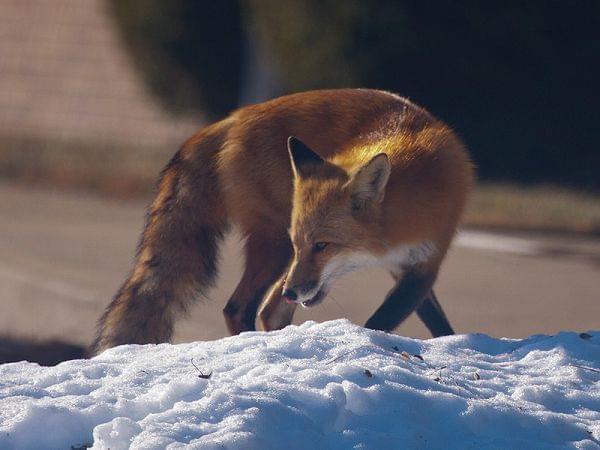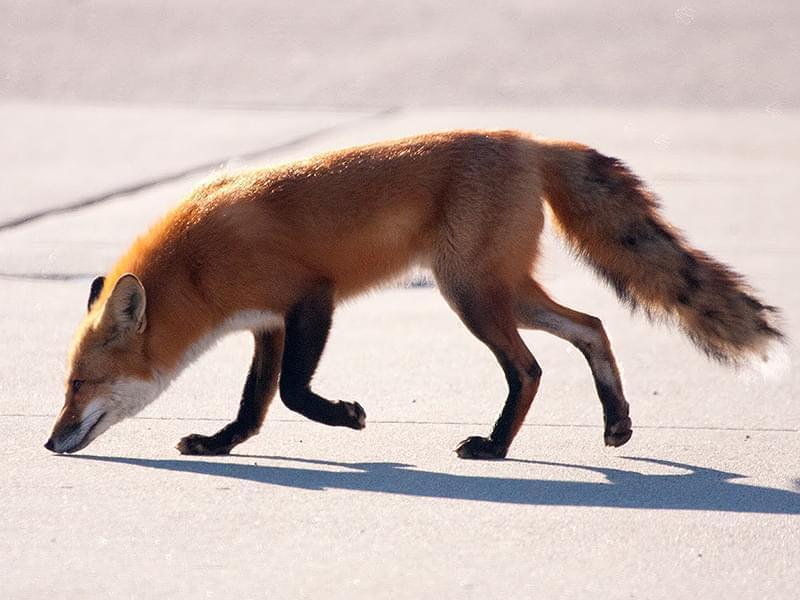Appreciating an adaptable urban carnivore

A red fox on a snowpile just off Springer Drive in Champaign Rob Kanter
On a cold, bright morning at the end of December, I was driving to Norris Tire and Auto in Champaign when I spotted a red fox trotting in the opposite direction, just off Springer Drive. I whipped the car around and got a few photos before it crossed Mattis Avenue and disappeared behind a pile of construction rubble.
When I arrived at the shop a short time later, I found people there had seen the fox, too, and Mr. Norris was explaining why we see more foxes in town now than we used to.
He referred to a study conducted by a UI doctoral student that looked at movements and mortality among 335 foxes that were captured and then tracked using radio collars between 1996 and 2002.*
According to that study, red foxes declined in rural parts of east central Illinois over the last three decades of the twentieth century as farming became more intensive (which reduced the amount of prey available by reducing cover) and coyote populations grew (because coyotes kill foxes).
At the same time, the study found, foxes thrived in urban areas, where coyotes are scarce and rabbits are more abundant.
That’s not to say life is ever easy for foxes. Fewer than one in four fox pups in the study survived through its first year, and only one in three adults made it through an average year. (Although urban foxes are safer from coyotes than their rural counterparts, they are much more susceptible to sarcoptic mange, a fatal infectious disease caused by mites.)
With such high mortality, foxes persist by reproducing at a high rate; females often breed in their first winter, and litters range from four to ten or more.

The same red fox later seen crossing a road near Springer Drive in Champaign
Why do people get so excited about seeing foxes? Ed Heske, a mammal ecologist at the Illinois Natural History Survey, credits the in-between space they occupy from a human perspective. “They’re cool because they’re wild carnivores, but they’re small enough not to be threatening.”
Indeed, even though its full coat and bushy tail can make it appear larger, an adult red fox typically weighs only somewhere between eight and 13 pounds—less than some housecats I know.
Foxes may not possess all of the cunning or wisdom attributed to them by folklore, but they are pretty amazing. Have you ever seen video of a fox pouncing to catch a small mammal--or, better still, seen that yourself?
Scientists know foxes are especially sensitive to the low-frequency sounds made by prey animals as they move about or chew. But research conducted recently in the Czech Republic suggests foxes may also possess a magnetic sense that helps them estimate distance. Such a sense would go a long way in explaining how a fox can leap into the air and punch through the snow to pin a mouse without having seen it.
To see a nice account this by Ed Yong on his Discover blog Not Exactly Rocket Science click here.
I think my own fondness for red foxes owes to their adaptability. They occupy an incredible range of habitats, from cities and farms, to forests, grasslands, mountains and deserts. They can den under a shed or pass through your backyard at night without attracting notice. They eat rabbits and other small mammals for the bulk of their diet, but they also take advantage of insects and fruit when those things are abundant.
I suppose they’re really a lot like us.
Be that as it may, I have no comment if you’re question is, “What does the fox say?”
* Published as "Survival and Cause-Specific Mortality of Red Foxes in Agricultural and Urban Areas of Illinois" by Todd E. Gosselink, et al. Journal of Wildlife Management 71(6):1862-1873. 2007. doi: http://dx.doi.org/10.2193/2006-020.

